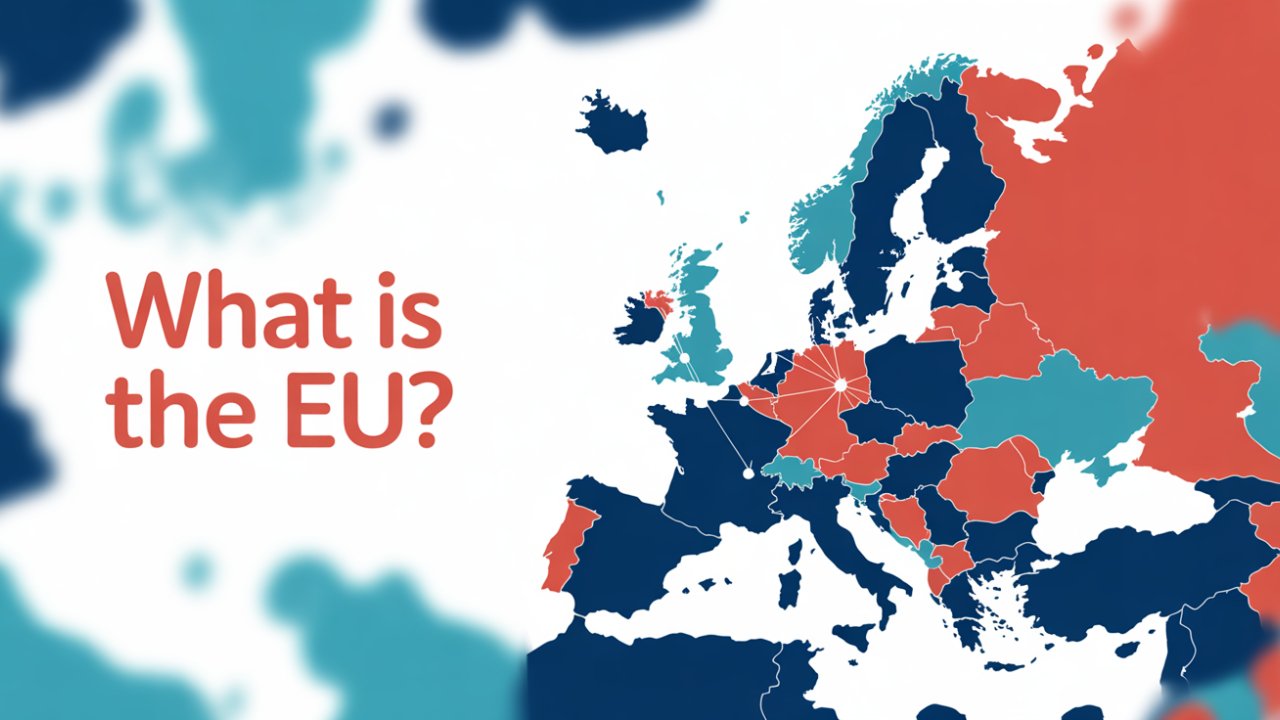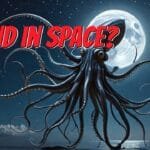You see its flag pretty much everywhere a circle of golden stars on a blue background. You hear its name in the news every day, tangled up in stories about trade, politics, and technology. Its rules quietly shape everything from the size of the bananas you buy, to your rights when your flight is cancelled, to the price of a phone call on holiday. It’s the European Union. We all know the name. But what is it?
Well, it’s not a country, like the United States of America. But it’s way more than just a club, like the United Nations. The truth is, the European Union is one of the most unusual, ambitious, and influential political creations in history. And it all started with a simple, almost shockingly radical idea, born from the absolute worst of times. An idea designed to make a third world war between France and Germany not just unthinkable, but ‘materially impossible.’
This is the story of how that one, desperate idea grew into a continent-spanning superpower; a political and economic union of 27 countries and over 449 million people. To get it, we need to go back. Back to a time when Europe was a continent of ash and ghosts.
The Ghost of Continents Past
Picture Europe in 1945. It’s not the postcard image of ancient cities we think of today. It’s a wasteland. For the second time in thirty years, a war had ripped the continent to shreds, leaving tens of millions dead, economies in ruins, and cities as wastelands of twisted steel. The air was thick with mistrust. The French mistrusted the Germans, the Germans mistrusted everyone, and the shadow of the Soviet Union was creeping over the East.
The problem was terrifyingly simple: how do you stop this from happening again? For centuries, Europe’s story was a story of war. A miserable cycle of conflict, a quick breather, and then even bigger conflict. The default setting between its great powers, especially France and Germany, was rivalry. They shared a border, a history of bad blood, and, crucially, the raw materials needed to build armies.
After World War One, the world tried punishing Germany, hoping to cripple its ability to start another war. The result? Resentment, economic collapse, and the rise of an even more aggressive regime that led straight to World War Two. Clearly, punishment didn’t work. So, after the second war, a new generation of leaders people who had actually lived through the horror knew they needed a completely different solution. The old ways were a spectacular failure. Something fundamental had to change.
The First Brick – Coal and Steel
The breakthrough came on May 9th, 1950. The French Foreign Minister, Robert Schuman, gave a speech that would change history. But it wasn’t some soaring declaration of brotherhood. It was something far more practical, almost… boring. And that was its genius.
Schuman proposed that France and West Germany and any other European country that wanted in should pool their entire production of coal and steel under a new, common, “High Authority.”
Now, why coal and steel? Because they are the ingredients of war. You need steel for tanks, guns, and ships. You need coal to power the factories that build them. For centuries, these resources, clustered along the Franco-German border, had been a source of conflict. Schuman’s idea was breathtakingly clever: if you force old enemies to share the literal building blocks of war, you make it materially impossible for one to secretly re-arm against the other. It was a checkmate against the old ways.
It was an economic solution to a political problem. It didn’t ask enemies to forget their hatred overnight. It just asked them to do business together, betting that shared economic interests could slowly, brick by brick, build trust.
In 1951, six countries France, West Germany, Italy, Belgium, the Netherlands, and Luxembourg signed the Treaty of Paris, and the European Coal and Steel Community (ECSC) officially came into force in 1952. This was the first brick. It was a small, technical organization, but it was revolutionary. For the first time, these nations had voluntarily given up a piece of their national power their control over a key industry to a higher, supranational authority. They chose cooperation over confrontation.
From an Economic Club to a Political Union
The ECSC was a huge success. It didn’t just help prevent conflict; it sparked incredible economic growth. The lesson was obvious: when you remove barriers and work together, everyone gets richer. So, they doubled down.
In 1957, the same six countries signed the Treaties of Rome, creating the European Economic Community (EEC). The goal was to take the “coal and steel” idea and apply it to their entire economies, creating a “common market” where goods could flow freely across borders without extra taxes or tariffs.
This kicked off a long, slow process of “deepening” and “widening.” Deepening meant more cooperation on things like farming, fishing, and eventually the environment. Widening meant more members. Through the 70s and 80s, countries like the United Kingdom, Ireland, Denmark, Greece, Spain, and Portugal joined. After the Berlin Wall fell in 1989, a wave of former communist countries from Central and Eastern Europe saw their future in the EEC, leading to a massive expansion in 2004.
This wasn’t always a smooth ride. It was a constant tug-of-war between national interests and the collective good. But with each new treaty, the project got more ambitious. The pivotal moment was the 1992 Maastricht Treaty. This is what officially created the European Union as we know it. It went way beyond economics, laying the groundwork for a single currency the Euro and establishing the idea of EU citizenship, plus cooperation on foreign policy and security.
The project had transformed. It was no longer just an economic club. It was now a political union, a complex hybrid the world had never seen before.
So, What Does the EU Actually Do? The Single Market and the Four Freedoms
Okay, that’s the history. But what does the EU do day-to-day? The heart of it all is one massive concept: the Single Market.
Think of it like this. Before the Single Market, a French company selling cheese in Germany would face a bureaucratic nightmare of tariffs, different food safety rules, and conflicting labeling laws. The Single Market gets rid of all that. It’s built on the “Four Freedoms”:
First, the Free Movement of Goods. That French cheese can now be sold in Munich as easily as in Paris. A car made in Slovakia can be sold in Sweden without trade barriers, creating huge competition and choice for consumers.
Second, the Free Movement of Services. A Polish software company can design an app for a client in Ireland. A Portuguese architect can design a public library in Finland.
Third, the Free Movement of Capital. This is the freedom to move money across borders. A German citizen can open a bank account in Spain, and an Italian pension fund can invest in a Dutch tech startup.
And fourth, the one that hits closest to home, the Free Movement of People. As an EU citizen, you have the right to live, work, study, or retire in any of the other 26 member states. A doctor trained in Lithuania can work in a hospital in Denmark. A student from Greece can attend university in the Netherlands for the same fees as a local.
Now, this is different from the Schengen Area, which is about abolishing passport controls at the borders. They overlap, but they aren’t the same thing one of those classic EU asterisks.
The Euro – A Single Currency for a Single Market?
If you have a single market, the next logical step is a single currency. It simplifies trade, encourages investment, and makes travel a breeze. That was the idea behind the Euro. Introduced for electronic payments in 1999 and as cash in 2002, the Euro was one of the EU’s biggest gambles. Today, 20 of the 27 EU members use it, forming the “Eurozone.”
So why not all 27? Because adopting the Euro means handing over the keys to your economic engine. You can no longer set your own interest rates or print money to fight a recession. That power goes to the European Central Bank in Frankfurt. Some countries, like Denmark, have an official “opt-out.” Others, like Sweden, have just… sort of… not joined by deliberately not meeting the criteria. And for newer members, joining is required eventually, but there’s no firm deadline. The Euro perfectly captures the EU’s core tension: the push for “ever closer union” versus the desire of nations to stay in control.
Who’s Running This Thing? The EU’s Bizarre Power Structure
So who’s actually in charge? This is where it gets confusing, because the EU’s structure doesn’t look like any government you know. Power is split between several key institutions in a unique balancing act.
Think of the EU as a company that develops rules for its 27 divisions (the member countries).
First, you have the European Commission. This is the company’s executive branch. Based in Brussels, it’s the only body that can propose new EU laws. It’s the engine. There’s one Commissioner from each member state, but they’re supposed to represent the interests of the whole EU, not their home country.
Next, any proposed law has to be approved by two different bodies. First is the Council of the European Union, which is like the board of directors, representing the governments of the member countries. When they talk farming, the 27 agriculture ministers meet. They bring their national interests to the table.
The second is the European Parliament, the only directly elected EU institution. It represents the citizens. Its members (MEPs) are elected every five years. In most cases, a law has to be approved by BOTH the Council (representing governments) and the Parliament (representing the people).
So who sets the overall strategy? That’s the European Council. This is the big bosses’ meeting, made up of the presidents and prime ministers of all 27 countries. They set the EU’s general political direction but don’t pass detailed laws.
Finally, you need a referee. That’s the Court of Justice of the European Union (CJEU). Its job is to make sure everyone institutions and countries plays by the rules. Its rulings are binding, and crucially, EU law is supreme over national law in the areas where members have agreed to cooperate.
It’s complicated, I know. A Commission that proposes, a Council and a Parliament that decide, another Council that directs, and a Court that referees. If you want a deep dive into how an EU law actually gets made, subscribe and let us know in the comments.
The EU in Your Daily Life
So what does all this history and all these institutions mean for you? The impact is often invisible, but it’s huge.
That two-year guarantee on your new phone? An EU law. Not paying insane roaming charges when you travel in the EU? That’s the EU. If your flight is severely delayed or cancelled, you’re entitled to compensation and assistance because of EU passenger rights.
The EU sets standards for cleaner air and water, establishes food safety regulations, and passed powerful data privacy laws like GDPR that have become a global benchmark. Its budget funds everything from new motorways in Poland and high-speed rail in Spain to scientific research and the famous Erasmus+ program, which has let millions of young people study abroad. This is the EU’s tangible legacy: a web of rules and rights designed to make life safer and easier.
The Cracks in the Union – Challenges and Controversies
Of course, it’s not all sunshine and tariff-free trade. The EU faces enormous challenges.
To many, the EU feels distant and bureaucratic a “democratic deficit.” This feeling was a major driver behind Brexit, when the UK became the first and only country to leave the EU, proving the push for “ever closer union” could be reversed.
The Euro has also been a source of tension. During the debt crisis in the 2010s, countries like Greece and Portugal couldn’t devalue their currency to recover, leading to painful austerity measures imposed as a condition for bailouts. This created deep resentment between wealthier northern countries and bailed-out southern ones.
Today, the EU faces a perfect storm of new challenges: the war in Ukraine, rising economic competition from the US and China, and the growth of populist parties arguing for a return of power from Brussels to national capitals. The Union’s unity is constantly tested by issues like migration, where member states have wildly different ideas.
Conclusion
So, what is the European Union?
It’s a peace project, born from the ashes of war, that has kept the peace among its members for over 70 years. It’s the world’s largest single market, an economic powerhouse that has brought incredible prosperity. It’s a club of 27 democracies that have agreed to pool their power to tackle challenges none could face alone.
But it’s also a messy and often frustrating compromise. It’s a constant battle between national interests and common goals, between the dream of a united Europe and the reality of 27 distinct cultures and histories.
The European Union is, in the end, an experiment. The most audacious political experiment of our time. It’s an attempt to answer a question that has haunted the continent for centuries: is it possible for the nations of Europe to live together in permanent peace? The experiment is ongoing, the outcome is not guaranteed, and the debate over its future is more intense than ever. But its existence has fundamentally reshaped our world.





